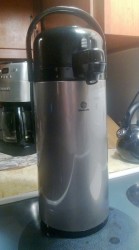 This is a Grindmaster Airpot. It has revolutionized my coffee routine. Here’s how: In the background of the picture you can see a Cuisinart Grind and Brew coffee maker. I received this coffee maker as a gift and I like it because it makes coffee made with beans that are ground immediately before being steeped. The problem with this coffee maker is that it has to be cleaned after every use and cleaning it is a lot like cleaning a gun, with the exception of having to oil it once I’m finished. Usually I forget to clean it, so the next day I have to waste paper towels drying the parts after I rinse them, or the grounds will stick in the works instead of going into the basket. What does this have to do with the Airpot? Well, as soon as I make coffee I pour it in the Airpot. That way I can immediately disassemble the Cuisinart and leave the wet parts in the drain rack to dry. Even better, the coffee isn’t sitting on a burner for 2 hours. This thing keeps coffee hot ALL DAY. Seriously, it’s still quite warm at 6pm. And it doesn’t have that burnt taste from sitting on the burner. This coffee thermos has turned into my own little caffeinated hummingbird feeder which I visit throughout the day for regular sips of hot Eight O’Clock coffee.
This is a Grindmaster Airpot. It has revolutionized my coffee routine. Here’s how: In the background of the picture you can see a Cuisinart Grind and Brew coffee maker. I received this coffee maker as a gift and I like it because it makes coffee made with beans that are ground immediately before being steeped. The problem with this coffee maker is that it has to be cleaned after every use and cleaning it is a lot like cleaning a gun, with the exception of having to oil it once I’m finished. Usually I forget to clean it, so the next day I have to waste paper towels drying the parts after I rinse them, or the grounds will stick in the works instead of going into the basket. What does this have to do with the Airpot? Well, as soon as I make coffee I pour it in the Airpot. That way I can immediately disassemble the Cuisinart and leave the wet parts in the drain rack to dry. Even better, the coffee isn’t sitting on a burner for 2 hours. This thing keeps coffee hot ALL DAY. Seriously, it’s still quite warm at 6pm. And it doesn’t have that burnt taste from sitting on the burner. This coffee thermos has turned into my own little caffeinated hummingbird feeder which I visit throughout the day for regular sips of hot Eight O’Clock coffee.
If you want one, search for a 2.2L Airpot, lever or push. 2.2L is 74 oz., so it will hold a regular 12 cup pot (72 oz.) with a little room to spare. I purchased mine at a yard sale for 5 dollars, but if you want one new you can buy it online for less than 50 dollars.
 The description read, in English and French, “Lozenges / Pastilles.” Now I’ve always associated lozenges with semi-opaque hard candy, like cough drops, so I was surprised to find fast dissolving tablets in the package. This made me curious about the definition of lozenge, so I looked the word up.
The description read, in English and French, “Lozenges / Pastilles.” Now I’ve always associated lozenges with semi-opaque hard candy, like cough drops, so I was surprised to find fast dissolving tablets in the package. This made me curious about the definition of lozenge, so I looked the word up.